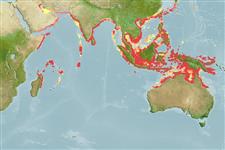分類 / Names
俗名 | 同種異名 | Catalog of Fishes(屬, 種) | ITIS | CoL | WoRMS | Cloffa
Elasmobranchii
板鰓亞綱 (鯊魚與魟魚) (sharks and rays) >
Carcharhiniformes (Ground sharks)
真鯊目 (Ground sharks) >
Sphyrnidae (Hammerhead, bonnethead, or scoophead sharks)
丫髻鮫科 (Hammerhead, bonnethead, or scoophead sharks)
Etymology: Eusphyra: eu- (Gr.), good, well or very; sphyra (Gr.), hammer, referring to immense hammer-shaped head. (See ETYFish); blochii: In honor of physician-naturalist Marcus Elieser Bloch (1723-1799), who described and illustrated this shark in 1785, which he identified as Squalus zygaena. (See ETYFish).
More on author: Cuvier.
Issue
Eusphyra laticeps (Cantor, 1837) is a valid species after Fernando et al 2019 (Ref. 120444).
Environment: milieu / climate zone / depth range / distribution range
生態學
海洋; 半鹹淡水 底中水層性; 非產卵性溯降河的 (Ref. 51243). 熱帶; 31°N - 20°S, 47°E - 154°E
Indo-West Pacific: Persian Gulf to the Philippines, north to China, south to Australia.
印度-西太平洋: 波斯灣到菲律賓,北至中國, 南至澳洲。
Length at first maturity / 大小 / 重量 / 年齡
Maturity: Lm ?, range 120 - ? cm
Max length : 186 cm TL 雄魚/尚未辨別雌雄; (Ref. 6871)
背棘 (總數) : 0; 臀棘: 0. Grey or grey-brown above, paler below. Expanded lateral blades of head very narrow and wing-like, with a series of small bumps along edges in front of nostrils; width across head 40 or 50% of total length. Nostrils enormously expanded, each nearly 2 times the mouth head (Ref 13562).
背面灰色的或灰褐色, 腹面灰白的。 擴大了頭部的側面葉片非常狹窄而翼狀的, 有一系列的小腫塊在鼻孔之前沿著邊緣; 橫過頭部 40 或 50% 的全長的寬度。 鼻孔非常地擴大, 每個幾乎兩倍嘴巴頭部 (參考文獻 13562).
Found in shallow water on continental and insular shelves (Ref. 244). Enters estuaries (Ref. 4832). Feeds mainly on small teleost fishes but also takes crustaceans and cephalopods (Ref. 13562). Viviparous (Ref. 50449), with 6 to 25 pups in a litter (Ref. 6871). Has a remarkable wing-shaped head which is nearly or quite half of its body length, the function of which is uncertain, maybe for maneuvering or for increasing the surface area of some of the sense organs (Ref. 244). Probably harmless to people (Ref. 13562). Caught commonly, but in low numbers, by inshore gillnet fisheries. Particularly common in catches off Kalimantan (Ref.58048). Probably a common fisheries species where it occurs (Ref. 13562). Meat utilized for human consumption; liver is a source of vitamin oil (Ref. 244). Offal probably utilized for fishmeal (Ref. 13562). Reported to reach 300 cm TL (Ref. 58784).
在大陸棚與島嶼棚上發現於淺水區.。 (參考文獻 244) 進入河口。 (參考文獻 4832) 主要吃小的硬骨魚也捕食甲殼動物與頭足類動物.(參考文獻 13562) 胎生的 (參考文獻 50449), 6 到 25個幼胎一胎.(參考文獻 6871) 有一個顯著的翼-形狀的頭部幾乎是或者相當一半它的體長, 功能是不確定的, 也許為驅動或為增加一些感覺器官的表面區域.(參考文獻 244) 可能對人無害.(參考文獻 13562) 可能一個普遍經濟魚種在那裡它出現.(參考文獻 13562) 肉供人類消費使用.; 肝臟是一個維他命油的來源。 (參考文獻 244) 碎肉可能利用.魚粉。 (參考文獻 13562) 報告達到 300 公分TL 。 (參考文獻 58784)
Viviparous, placental (Ref. 50449), with 6 to 25 in a litter after a gestation period of 8 (Ref.58048) -11 months (Ref. 6871). Size at birth between 32 and 45 cm TL (Ref. 13562).印度-西太平洋: 波斯灣到菲律賓,北至中國, 南至澳洲。
Compagno, L.J.V., 1984. FAO Species Catalogue. Vol. 4. Sharks of the world. An annotated and illustrated catalogue of shark species known to date. Part 2 - Carcharhiniformes. FAO Fish. Synop. 125(4/2):251-655. Rome: FAO. (Ref. 244)
IUCN 瀕危狀態 (Ref. 130435)
瀕危 (EN) (A2d+3d); Date assessed: 18 February 2015
人類使用
漁業: 商業性
工具
特別的報告
下載 XML
網路資源
Estimates based on models
Preferred temperature (Ref.
123201): 25.2 - 29.1, mean 28.3 °C (based on 970 cells).
Phylogenetic diversity index (Ref.
82804): PD
50 = 1.0010 [Uniqueness, from 0.5 = low to 2.0 = high].
Bayesian length-weight: a=0.00513 (0.00275 - 0.00956), b=3.24 (3.07 - 3.41), in cm total length, based on LWR estimates for this species & (Sub)family-body (Ref.
93245).
營養階層 (Ref.
69278): 4.2 ±0.6 se; based on diet studies.
回復力 (Ref.
120179): 非常低的, 最小族群倍增時間超過14 年 (Fec=6).
Fishing Vulnerability (Ref.
59153): Very high vulnerability (90 of 100).
Nutrients (Ref.
124155): Calcium = 16.6 [2.7, 88.0] mg/100g; Iron = 0.526 [0.132, 1.586] mg/100g; Protein = 18.9 [16.9, 21.1] %; Omega3 = 0.129 [0.056, 0.295] g/100g; Selenium = 76.7 [22.3, 229.5] μg/100g; VitaminA = 19 [8, 48] μg/100g; Zinc = 0.721 [0.349, 1.352] mg/100g (wet weight);
